Ahhh Greece, where the warmth of the people is as inviting as the Mediterranean breeze, and the cuisine is as rich as its history.
Stunning coastlines, crystal clear waters: That and much more awaits you spearfishing Greece.
Spearfishing in the Aegan Sea is a part of a fishing culture that has thrived alongside the sea for thousands of years.
Greece’s serene waters and diverse marine life make it an ideal destination for beginners. Here, in the calm and clear waters of the Mediterranean, shy fish teach you the art of patience and stealth, essential skills for any aspiring spearo.
In this guide, with insights from my friend Dimos Adamis – a five-time spearfishing world record holder and experienced guide – I will take you through everything you need to know about spearfishing in Greece: From targeting local species and picking the right gear to finding the country’s best spots.
TL;DR
Best time to visit: June, early July, September, October (Avoid mid-July & August due to boat traffic & fish scarcity)
Visibility: 10- 30 m
Species: Dentex, Grouper (Dusky, Goldblotch, White), Seabream, Amberjack, Parrotfish, Octopus
Top Destinations: Andros, Halkidiki, Crete (South), Rhodes, Kythira
Spearfishing Regulations in Greece
From licensing requirements to restricted areas and species, this section covers the key regulations you need to know before you embark on your Greek spearfishing adventure.
Let’s dive into the legal side of things, so you can enjoy your spearfishing journey with peace of mind.
Spearfishing Greece Licence
Good News for my fellow tourist spearos: In a welcoming move for spearfishing enthusiasts, Greece has simplified its regulations, eliminating the need for a special spearfishing licence in 2017.
There is some misinformation out there, stating that you need a licence of any sort.
As of 2024, you do not need a license for spearfishing, nor for fishing from the shore or boat for recreational purposes in Greece.
Spearfishing Laws in Greece

Actually, the official info on regulations for spearfishing can be really hard to find for foreigners, and some of the info on the net is also outdated.
But I contacted the greek government via e-mail and they sent over some resources:
Despite these challenges, here’s what I found:
- Safety is paramount, so using a dive buoy with a flag during underwater activities is mandatory, and you must stay within 50 meters of it.
- Adherence to daily catch limits helps preserve marine life; you’re allowed up to 5 kg of fish per day or one larger fish.
- “It is prohibited to sell and in general to trade catches from recreational fishing.” (P.D. 373/85)
- Spearfishing is confined to daylight hours, from sunrise to sunset, and using a torch is prohibited.
- Also you are not allowed to spearfish in May (officially due to spawning time; but according to Dimos it has more to do with the interests of the fishing industry).
- One fish of the Epinephelus species per spearo per day.
- For the safety of all, maintain a distance of at least 300 meters from swimming areas (and as we know it from other countries, probably harbours as well).
- Be aware that certain areas, like NATURA 2000 sites and military zones, are off-limits, and violating these regulations can lead to significant fines and equipment confiscation.
- Additionally, respecting the minimum legal sizes for different fish species is key:
According to Greek law, Epinephelus species (groupers) must be at least 45 cm in length to be legally harvested.
Additionally, any fish under 150 g are generally prohibited from being taken, regardless of species.
However, if you want to fish sustainably, especially when it comes to Dusky groupers, 45 cm is far too small. A Dusky grouper of that size typically weighs around 1.5 kg, meaning it hasn’t yet reached sexual maturity or participated in the spawning cycle.
For true sustainability, consider setting your personal minimum at 2.5–3 kg. That way, you’re helping to protect a vulnerable species with slow growth and late reproduction.
Spearfishing Greece Types of Fish
Legal Minimum Fish Sizes Greece
I reached out to the Greek government and got the info: For some fish in the Mediterranean, the minimum sizes are decided by the EU Regulation – specifically, the European Regulation (EU) 1241/2019 Annex IX Part A. For other species, it’s Greek laws that call the shots. So a mix of local and EU Regulation…
Minimum Conservation Reference Sizes (MCRSs) are super crucial for keeping our seas healthy. They’re set for all EU countries and are in play until December 31, 2023.
| Species (Common and Latin Name) | Minimum Legal Size |
|---|---|
| European Seabass (Dicentrarchus labrax) | 25 cm |
| Dusky & White Grouper (Epinephelus marginatus & aeneus) | 45 cm |
| Common Dentex (Dentex Dentex) | 45 cm + (recommended) |
| Pompano (Trachinotus ovatus) | 8 cm |
| Common Octopus (Octopus vulgaris) | 750 g (1 kg recommended) |
| Lobster (Homarus gammarus) | 105 mm CL (carapace length) |
| Annular Seabream (Diplodus annularis) | 12 cm |
| Sharpsnout Seabream (Diplodus puntazzo) | 18 cm |
| White Seabream (Diplodus sargus) | 23 cm |
| Two-banded Seabream (Diplodus vulgaris) | 18 cm |
| Stripped Seabream (Lithognathus mormyrus) | 20 cm |
| Spanish Seabream (Pagellus acarne) | 17 cm |
| Red Seabream (Pagellus bogaraveo) | 33 cm |
| Common Pandora (Pagellus erythrinus) | 15 cm |
| Common Seabream (Pagrus pagrus) | 18 cm |
| Gilthead Seabream (Sparus aurata) | 20 cm |
| Chub Mackerel (Scomber japonicus) | 18 cm |
| Hake (Merluccius merluccius) | 20 cm |
| Red Mullets (Mullus spp.) | 11 cm |
| European Sardine (Sardina pilchardus) | 11 cm |
| Atlantic Mackerel (Scomber scombrus) | 18 cm |
| Common Sole (Solea vulgaris) | 20 cm |
| Horse Mackerel (Trachurus spp.) | 15 cm |
| Scallop (Pecten jacobeus) | 10 cm |
| Carpet Clams (Venerupis spp.) | 25 mm |
| Venus Shells (Venus spp.) | 25 mm |
Other species that you can encounter in the Meds are listed here (with pictures), but unfortunately without minimum landing sizes.
Protected (Fish) Species in Greece
Annex 1 of the before mentioned document also lists all "Prohibited Species" in EU waters.
I'll give you the quick rundown...
Stay away from spearing and harvesting:
- Any type of (Manta) Rays (or species that look like rays)
- Sharks
- Hatpin Urchin (Centrostephanus longispinus)
- Female Lobster (Homarus gammarus) and Female Crawfish (Palinurus spp.) that are carrying eggs ("Berried")
- Date shell (Lithophaga lithophaga), Fan mussel (Pinna nobilis) & Common piddock (Pholas dactylus)
If you want to use sea urchin as burley, here is how you differentiate the sea urchins found in Greek waters:
Protected:
Hatpin Urchin (Centrostephanus longispinus) : Look for exceptionally long, slender spines, like hatpins. They're typically found in deeper, rocky areas.
Good to Go:
Paracentrotus lividus: Common in shallower waters, these urchins have shorter, thicker spines and a greenish-brown to purple hue.
Arbacia lixula (Black Sea Urchin): Easily spotted with its short, thick black spines, this urchin is a regular in Greek seas.
Diadema setosum (Long-spined Sea Urchin): Invasive; good eating (with lots of roe inside); very long spines; spines are poisonous.
Spearfishing Dentex in Greece
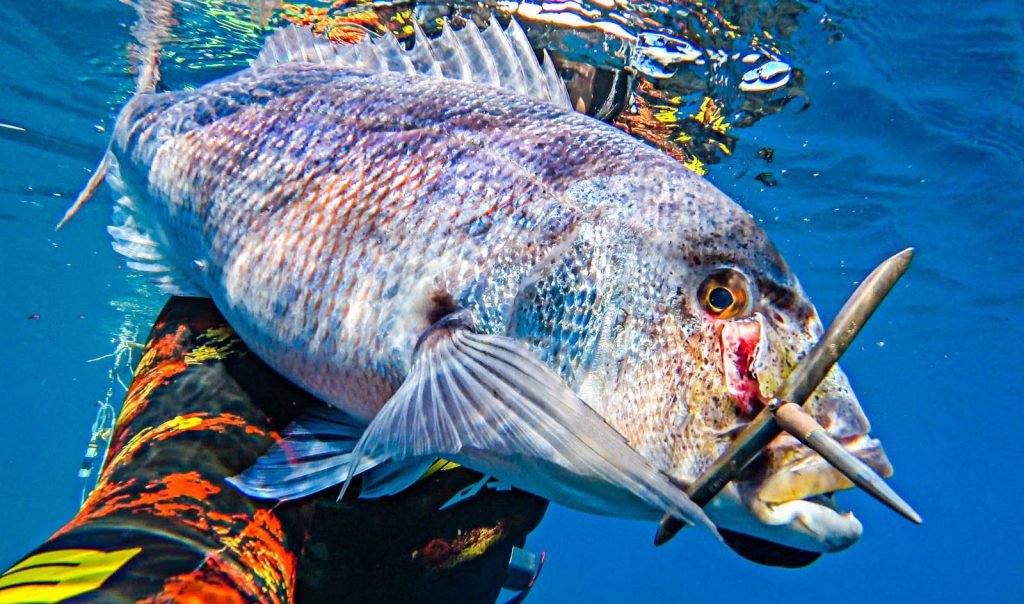
Spearfishing for Dentex in Greece demands strategic savvy and patience.
I would recommend choosing flat seabeds with rocks or posidonia (neptune grass) for better hunting grounds. Avoid areas with significant drops, as it's more challenging to catch Dentex in these locations.
Tool Tip: A really good free tool for finding good spots for dentex is the Navionics ChartViewer. Here you can see the depth charts to plan your Dentex spearfishing trip.
Also stealth is vital. Approach your ambush spot hidden by rocks to pique the Dentex's curiosity.
A quiet dive and minimal movement on the seafloor are crucial.
Use shadows and terrain to stay concealed, with your fins down and gun hidden. Dentex often swim in groups, following each other's direction and responding to currents.
They typically swim vertical to the current, allowing for easier prediction of their path.
If you are further interested in the topic, I have found an amazing video by Spearfishing Life that will explain how to hunt dentex in greece.
The prime Dentex fishing season in Greece is from late spring to early autumn, typically May to September.
During these months, Dentex are more active near the shore due to warmer water temperatures, making them easier to spearfish.
In cooler months, they move to deeper waters, making them harder to target.
For the best chances, try early morning or late afternoon/evening, but local advice is key for precise timing in your area.
I would recommend a minimum landing size of 45cm + for Dentex (see table) since they reach sexual maturity typically at around 35 to 40 cm in length.
This recommendation is aimed at ensuring the sustainability of the species by allowing individuals to participate in the breeding cycle before being harvested.
If you are interested in learning how to catch this species, you can check out Dimos's video on spearfishing Dentex in Greece:
Spearfishing for Seabream (Dorade) in Greece
This one is for us spearos, who find pleasure in the hunt for dinner, not just the pursuit of the largest catches:
One of my all-time favorite species to hunt in Greece has to be the Seabream.
Oh, and let me tell you, there’s nothing quite like the taste of a Seabream freshly caught off the coast of Halkidiki. The meat is so juicy and white, it's just out of this world.
Now, the big Seabreams, they're a clever bunch. I’ve had my fair share of adventures hunting them while shore diving, even in the shallower waters. You've got to find a good spot to hide, e.g. behind some underwater structure, and then wait, super calm and collected. Interestingly, I’ve found that Sharpsnout Seabreams are somewhat easier to hunt.
Sometimes it pays off to follow seabream for a little while, even when you spook them. They might hide behind a rock, where they feel safe. That would be your chance to strike.
Remember, when you're spearfishing for Seabreams in Greece, the size matters and varies by sub-species. They should measure between 12 to 33 cm. I know, given the variety, it can be a bit tricky to judge the size underwater, but differentiating the species pays off- you will have a clear conscience.
Book your Guided Spearfishing Trip in Greece!
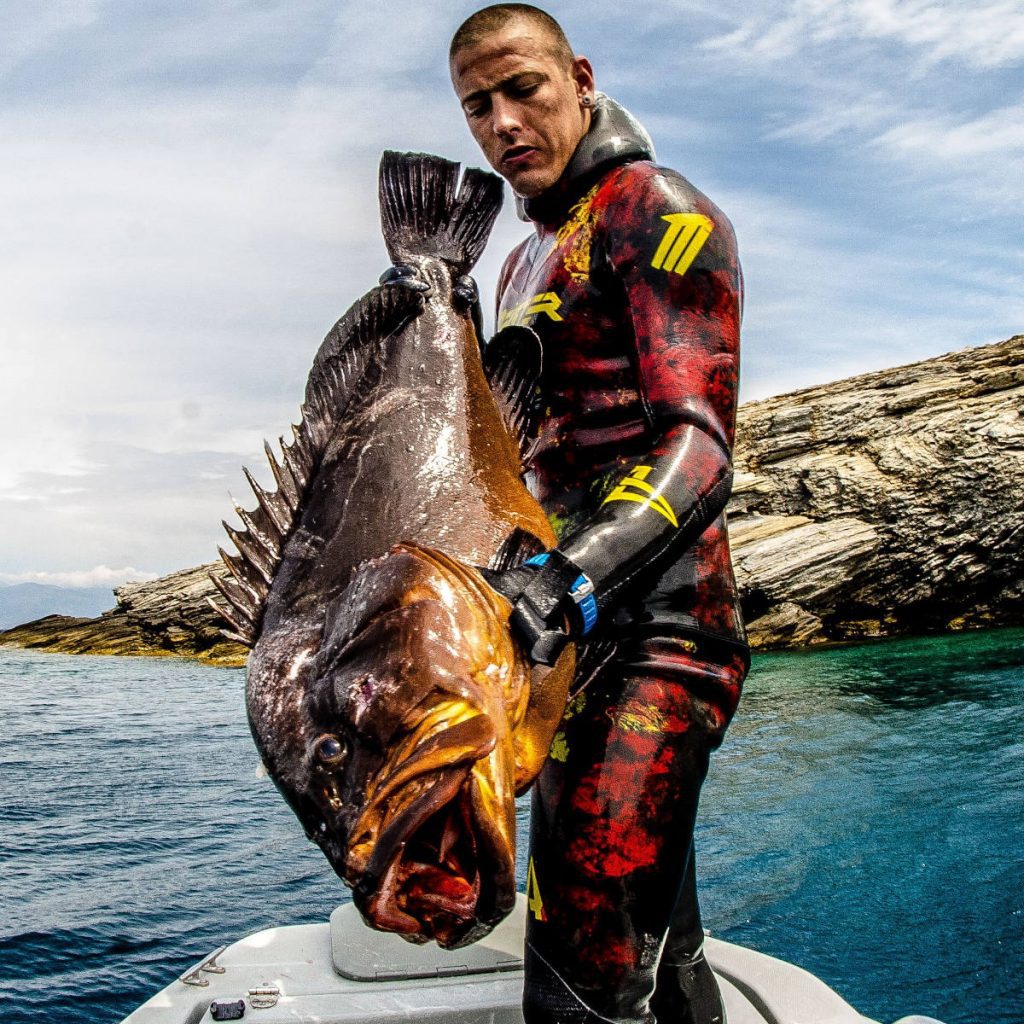
Ready for Your Guided Spearfishing Adventure in Greece?
Your Guide will handle everything- you just show up and chase the big ones.
Spearfishing Bluefin Tuna in Greece (prohibited)
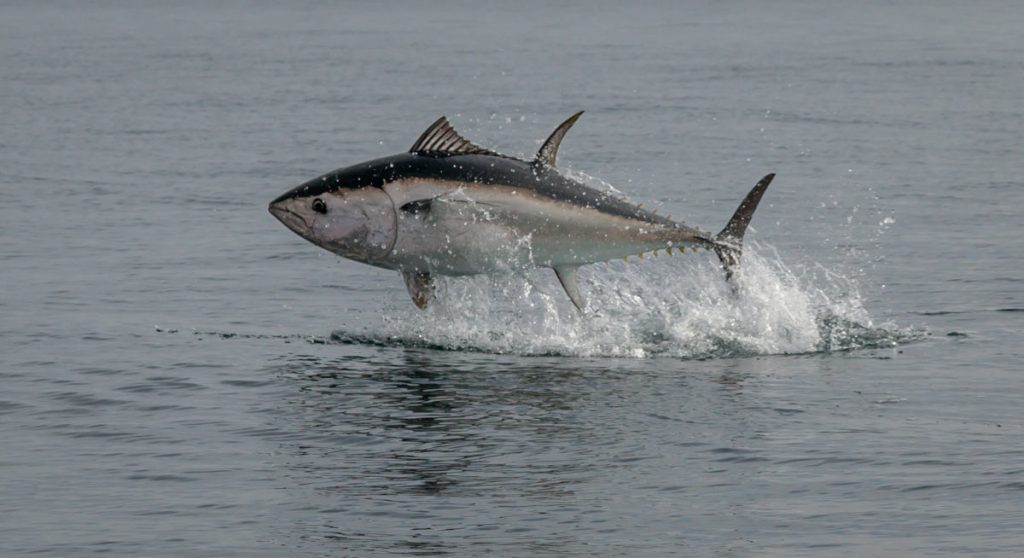
Bluefin tuna spearfishing is illegal in Greece because the country’s entire fishing quota for tuna is allocated to a small number of licensed commercial boats- leaving no allowance for recreational or spearfishing activities.
Here is what Dimos has to say to this:
“In every country, 10% of the quota goes to recreational fishermen. But here in Greece, they give no quota for us. The whole quota of the country goes to 27 professional fishing boats. That’s why spearfishing for tuna is prohibited.”
Octopus Spearfishing in Greece

Spearfishing for octopus is a long-standing tradition in Greece. You can catch them using a speargun, ideally with a trident tip.
Or you can use an Octopus Hook, which is a metal bar with a curved end.
However, it's interesting to note that most locals prefer catching them by hand.
This way you can make sure the octopus is big enough to take home, even after catching it.
Last I checked (Summer 2023) the minimum size limit for Octopus in Greece was 500g (1.1 pounds). There seems to be no official information about the minimum size limit right now. I have contacted the greek ministry of maritime affairs.
For sustainable spearfishing and to adhere to the law to catch the Common Octopus (Octopus vulgaris), aim for individuals weighing at least 1 kg (2.2 lbs).
According to a study done in South Korea, this weight generally indicates maturity for both males and females, ensuring they've had a chance to reproduce.
Cooking Tips:
Option 1: Freeze the octopus before you cook it. Then slow cook it. This will tenderize the meat.
Option 2: Cook it for 1,5 hours + on low heat. Before cooking, add 1 glass of white wine and ½ a glass of balsamic vinegar and some bay leaves (keep the beak, put the octopus in the pot with the tentacles on top).
(Fun Fact: It is greek tradition to tenderize octopus by striking it against a rock 40 times.)
One of my favourite dishes is an Octopus Salad (see below) with Pomegranate, Cilantro, Cherrytomatoes, and Paprika.

Where can you catch octopus in Greece?
On my vacation in Paros, a local revealed they catch octopus by hand, highlighting the abundance in places like Sifnos. The Cyclades, including the tranquil Sifnos, Naxos, and Antiparos, are hotspots for octopus fishing.
In Lesvos, known for its seafood, and Crete's quaint villages like Agia Galini and Plaka, octopus is a culinary highlight. On the Peloponnese coast, towns like Gytheio in Laconia celebrate octopus as a staple catch.
Spearfishing Grouper in Greece
The best time for spearfishing grouper in Greece is typically during the warmer months, from late spring to early autumn, when the waters are clearer and the fish are more active.
Islands like Crete, Rhodes, and the smaller, less frequented islands of the Cyclades and the Ionian Sea offer some of the best spots for this activity.
Successful grouper spearfishing requires patience, stealth, and a good understanding of the fish's habits and habitats.Grouper are cautious and can quickly retreat into their rocky hideouts, so a strategic approach and accurate shot are crucial.
Let's hear what Dimos Adamis, world record holder, has to say about hunting them:
"The most effective method to spot groupers is the ambush or dynamic ambush.
Fish like Golden groupers, White groupers, Mottled groupers are easier to approach you while you are at the ambush.
Less likely for a Dusky grouper to do that.
If you spot a fish that holds his position, try to slowly drag yourself across the seabed to get int shooting range!"
If they disappeared into a cave it is worth to check it out: They are curious. Sometimes pop their head out of the cave.
Groupers’ territorial and sedentary nature can make them vulnerable to overfishing. Their tendency to return to the same spots and their slow-moving behavior make them easier targets for fishermen and spearfishers.
This vulnerability is compounded by their long lifespan and late maturity, which means it takes them longer to reproduce and replenish their populations.
The Dusky Grouper reaches sexual maturity around 40-50 cm (15.7-19.7 inches) for males and 50-60 cm (19.7-23.6 inches) for females.
To ensure that grouper populations remain healthy and stable for future generations, make certain you do not catch any Groupers below 45cm and maybe even aim a little higher in the 60+ cm range.
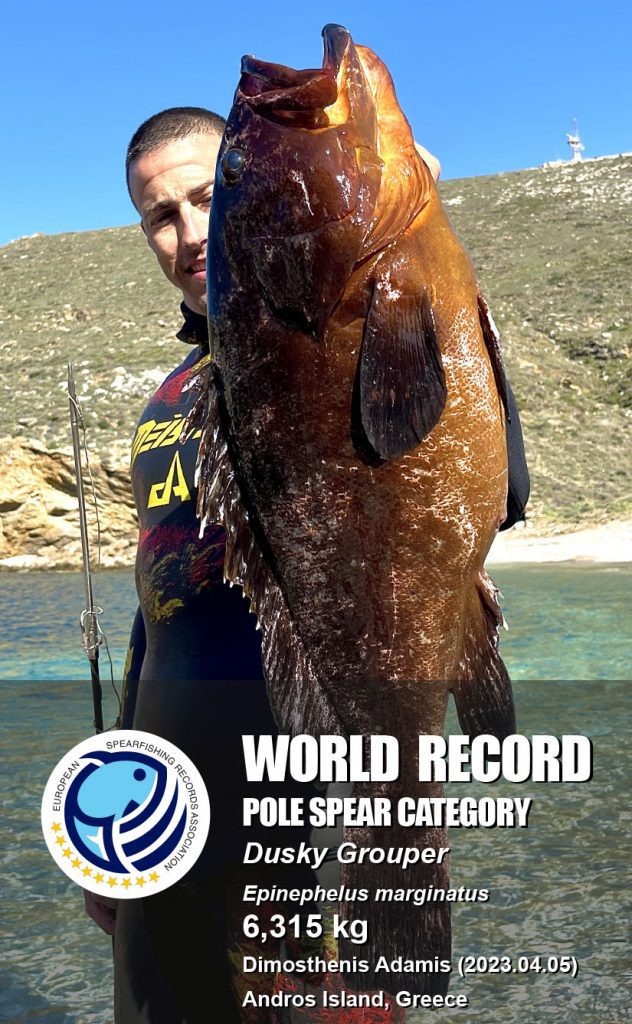
Gear for Spearfishing in Greece

Speargun Choice for Greek Waters
As always, the choice of a speargun in Greece largely depends on the type of fish you are aiming to catch.
For targeting smaller reef fish such as seabream and octopus, a compact 65 cm speargun is quite effective. Its smaller size allows for greater maneuverability in tight reef spaces, making it ideal for these types of catches. (I even started with a 50cm speargun.)
However, if you're looking for a versatile option that covers a wider range of spearfishing activities, I recommend opting for a 75 cm gun. This size strikes a perfect balance, offering enough power and range for various fish sizes while still maintaining ease of handling.
Dimos Adamis recommends a speargun of at least 105cm with 7-7,5-8mm shafts and multiple bands, or rollers or invert rollers, providing the necessary range and power to target big Groupers and elusive Dentex.
Pro Tip: Since fish are pretty shy in the Meds, you will not always get a chance to line up "the perfect shot". So it is pretty normal to hit the rocks here and there. Bring enough replacement shafts and a file for sharpening your speartips.
Wetsuit Choice for Greece
Your wetsuit choice largely depends on the specific location, the depth at which you'll be diving, and the duration of your time in the water.

However, based on my experience and the conditions typically encountered in Greek waters, I've found that a 3mm wetsuit is perfectly suitable for summer spearfishing.
If you are planning to stay longer than 3 hours in the water, a 5mm is an even better choice.
The average water temperature between 21-28 ℃ (72-82 °F) in Greece during June to September makes a 3mm wetsuit comfortable enough to maintain body heat without overheating.
If you plan to spearfish in Greece in cooler seasons like spring or autumn, you might want to consider a 5mm Wetsuit.
If you plan to spearfish in Greece in cooler seasons like spring or autumn, you might want to consider a 6,5mm Wetsuit.
Pro Tip: If you are spearfishing in Greece throughout the year and you only want to buy one wetsuit, you can buy a 5mm wetsuit. In summer you wear only the upper body part with some shorts.
Best Spearfishing Destinations in Greece
Andros Island in the Cyclades
Andros is a top summer destination in the Cyclades, just one hour by ferry from Athens. The island combines crystal-clear waters, dramatic mountains, waterfalls, and authentic Mediterranean cuisine.
With 176 km of shoreline, Andros offers endless spearfishing spots-especially if you're targeting groupers. Goldblotch groupers, in particular, are known to inhabit the rocky underwater terrain around the island, making it a prime destination for experienced hunters.
Andros is also steeped in history: Strofilas, Europe’s oldest known town (4500 BC), was discovered here.
Book a Spearfishing Guiding in Greece
You want more than just a casual dive?
Experienced spearfishing guide and several world record holder Dimos Adamis offers a guided spearfishing experience in Andros.
The trip runs over two full days and includes guided shore dives across the island’s wildest, fish-rich areas.
Target species often include groupers, goldblotch groupers, and other seasonal favorites. Depending on the weather, a boat dive to a local shipwreck can be arranged.
What’s included:
- 2 days of spearfishing (4–6 hours/day)
- 3 nights accommodation with sea views in Gavrio
- Daily breakfast + catch-and-cook dinners
- Coaching from a certified spearfishing & freediving instructor
- Underwater photography and video of your dives
- Transport to dive sites via 4x4 (boat option available)
- Lunch at a traditional seaside taverna
- All local logistics and safety covered
Pricing:
- Starting from €1400 for 1 person (full trip)
- €600 per additional diver per day
- €250 deposit required to secure a spot
- Equipment rental available on request
The experience is limited to max. 3 divers to ensure personal guidance and safety. This trip is open to certified freedivers of all levels.
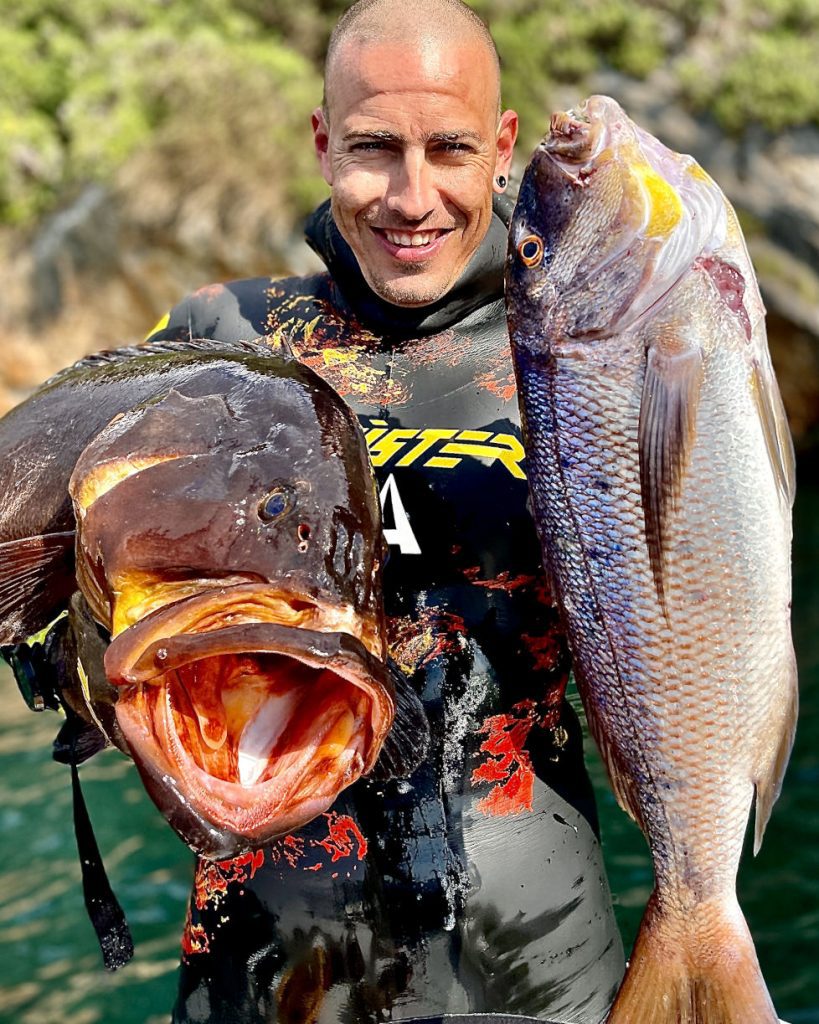
Interested in a Guided Spearfishing Trip in Greece?
Dimos is going to take you on a trip you will not forget!
Spearfishing Halkidiki- Everlasting Memories
When I decided to go Spearfishing in Halkidiki the past Summer (2023) I did not get disappointed. Conveniently located near Thessaloniki, Greece's second-largest city, Halkidiki is just about an hour's drive away, making it easily accessible for a quick spearfishing getaway.
Storytime:
On my solo trip to Thessaloniki, I spent the initial days acquainting myself with the local waters, shaking off the dust from my lungs and fins through some freediving practice.
My goal was clear – to indulge in spearfishing.
I casually mentioned my spearfishing plans to my Airbnb host.
On the third day, a voice outside my room sparked my attention, "Do you know any good spearfishing spots around here?"
In an instant, I was out of bed and at the door. Stepping outside, I saw two guys, their spearguns casually propped against the balcony.
My curiosity led me to ask, "Are you guys going spearfishing?"
That question opened the door to three incredible days of spearfishing adventures together.
Arijan was the seasoned spearo, while Joeri, like me, was just starting.
Arijan, with his wealth of experience, became a mentor, showing me the art of silently approaching groupers and the intricacies of maintaining the speargun.
During those days, I managed to spear a few parrotfish and some delicious seabream.
On our last day, Arijan skillfully caught a golden grouper.
Funny enough: The Grouper tore off the first spear but he quickly grabbed my speargun, dove down and shot it again.
We decided to celebrate our catch by taking it to a local restaurant.

It took us three attempts to convince the restaurant owners to cook our catch – a challenge likely due to the area's touristic vibe.
But once they agreed, it was the perfect end to an unforgettable spearfishing adventure in Thessaloniki.
… back to the Guide:
The peninsula, known for its three distinctive "legs," offers a variety of spearfishing environments. However, it's important to note that spearfishing is prohibited in certain areas, like the Holy Mountain in Athos and Thermaikos Bay from Thessaloniki to the Village Posidi.
The First Leg: Kassandra
The first leg of Halkidiki, particularly around Paliouri, is a popular spot for spearfishers. While the fish population here may not be as abundant due to industrial fishing, the moon phases and weather conditions can lead to encounters with larger specimens.
Common targets in this area include groupers, red snappers (Dentex Dentex), golden groupers, white breams, Amberjacks, and Bluefish.#
Careful: You are not allowed to spear in the Gulf of Thessaloniki!
The Second Leg: Sithonia
On the second leg, Porto Koufo stands out as a prime spearfishing destination. This naturally enclosed, deep bay is shielded from adverse weather, making it an ideal spot for both anchoring boats and spearfishing.
Leaving Porto Koufo and heading southeast, spearfishers will find numerous spots, with the sea bottom becoming much steeper and currents stronger. In these waters, spearfishers can encounter big red snappers and huge golden groupers below 20 meters.
Groupers in this area are known for their cunning, often watching from the bottom and quickly hiding in their holes.
For the more adventurous, open water fishing around big isolated rocks presents opportunities to encounter large schools of Amberjacks, especially in June.
The Third Leg: Agios Oros
Situated between Halkidiki's second and third legs, Ammouliani Island is a gem accessible by a regular summer ferry from Tripiti or more directly by boat. The area around the island benefits from the restrictions of the nearby Holy Mountain national park, creating a refuge that attracts a variety of fish, including red snappers and golden groupers, especially during the summer months.
For an adventurous spearfishing experience, focus on the deep underwater landscapes around Ammouliani, where the seabed plunges to depths of 35-40 meters. These underwater mountains,' are the haunts of larger Dentex and Golden Grouper.
Spearfishing Crete

Southern Crete
The southern parts of the island are particularly renowned for their spearfishing spots (e.g., Tsoutsouros, Matala).
Here, due to heavy fishing, fish like Sargos (Sea Bream), Lavraki (European Seabass), and the elusive Grouper tend to be found in deeper waters and display remarkable intelligence, making them a rewarding challenge for skilled spearos.
The south coast, with locations like Plakias, Rodakino, and Agio-Galini, offers rocky walls and clear waters with visibility up to 15 meters, ideal for encountering a variety of fish including Groupers and Dentex.
Lionfish, an invasive species, are increasingly common in Crete, particularly in the south. While absent in the north, places like Sougia are teeming with them, often found under rocks at depths ranging from 3 meters in summer to 15 meters in winter.
In Tsoutsouros, they are at shallower depths, whereas near Matala, which experiences more wave action and regular hunting, they prefer deeper areas.
Northern Crete
In the northern region, especially around Rethymnon, spearfishers can find diverse seabeds ranging from sandy bottoms in Adelianos Kambos, ideal for hunting Mayatiko (Amberjack), to the rock and sand terrains in areas like Skaleta and Panormo-Bali, where Grouper, Sargos, and Dentex are prevalent.
Spearfishing Santorini
One notable spearfishing spot in Santorini is Kamari, located in the southeast. Protected from waves, this area offers a coral reef that descends to 19 m (62 feet), providing a habitat for octopuses and nudibranchs. It’s a popular site for both beginners and seasoned spearfishers, thanks to its diverse underwater environment and manageable depth.
To find more good spearfishing spots in Santorini I would advise you to check out the depth charts and ask locals for intel.
Spearfishing in Rhodes

Lindos, known for its stunning views is also noteworthy for its dramatic underwater drop-off, creating ideal conditions for spearfishing.
Rhodes is also known for it's squid fishing- keep an eye out for these delicious creatures and ask
On one occasion, I encountered a sizable school of amberjacks in this region. They were within an arm's reach, presenting a perfect opportunity. I
Storytime: Let me take you back to my first spearfishing adventure.
I remember hopping on my scooter, buzzing off to this pretty remote spot.
The ride was a bumpy one, traversing through rough terrain, but oh, was it worth it!
I arrived at this secluded paradise with three stunning beaches and hardly a soul in sight.
That's where I speared my very first fish.
It was lurking near the seabed, about 6 meters deep. I remember diving down, eyes locked on my target. Just as it noticed me and darted towards the rocks for shelter, I took my shot. Got it, just a millisecond before it could disappear behind the rocks – talk about a heart-racing moment!

Back on the beach, I bumped into two Moroccan guys. We shared a moment under the sun, they offered me some of their pineapple, and I lent them my dive mask to check out the nearby reef.
It was one of those perfect days where everything just comes together – the thrill of the catch, the beauty of nature, and the simplicity of human connection.
Can you identify it for me?
FAQ
Is spearfishing allowed in Greece?
Yes, spearfishing is allowed in Greece. In 2017, the regulations were simplified, and now tourists don’t need a special license for spearfishing.
Can you spearfish in Crete?
Yes, spearfishing is popular in Crete, especially in the southern and northern regions, with clear waters and a variety of fish like Groupers, Sea Bream, and European Seabass.
Where is the best spearfishing in Greece?
The best spearfishing in Greece is found in Andros Island, Halkidiki, Crete and even smaller islands like Kythira & Antikythira (hidden gems with low tourist density).
Disclaimer: The information provided on this blog is intended for general informational and educational purposes only and does not constitute legal, sporting, or professional advice. Spearfishing involves inherent risks, and the regulatory information presented herein may not be current or complete. Before engaging in spearfishing or relying on any information from this blog, readers should verify the applicable local laws and safety regulations and consult with appropriate professionals as needed. Under no circumstances will the blog author or publisher be liable for any direct, indirect, incidental, consequential, or other damages arising from any reliance on the content provided.



14 Comments
I think it’s your first fish
Symphodus tinca, Linnaeus
Yes, you might be right! 100 Spearo Points for you. 😀
Thanks for the guide and your stories. I’m planning to go for vacation to Thessaloniki end of June and try to go for spear fishing. I’m a beginner so your guide was extremely helpful. Good luck 🍀 and stay safe.
Hey man, glad that I could help! Northern Greece is great for spearfishing. Happy Spearing & Stay Save!
Amazing guide. I spearfish since last year. My first fish ,oddly enough ,was a trigger fish in the island of Astipalia. I my mentor is google and i have geat difficulty catching groopers , dentex and baracudas ( not even one ).
Yeah man, I can relate. Catching Grouper takes patience in the meds. Dentex is a totally different game. Maybe you will find someone to spearfish with, if you stick around spearfishing forums and reddit. Or do a guided trip- even better. 🙂
Very cool guide! I am planning a trip to Greece this summer and am decideing between Thessaloniki and Athens. I have been to both before and would like to spend 3/6days spearfishing this time. I only have some experience freediving so I,m wondereing if you have any advice for finding guides in the peninsula as described in this article. My other option is to drive to Zante from Athens and to go with familly friends which has obvious upsides but also maybe downsides.
Hey Jaggy, if you want to I could introduce you to a local guide in the Athens Area, who could also recommend sth. for Thessaloniki if needed?
Hey Björn, wow that would be perfect! I haven’t been able to find anything else so yea that would be amazing. jaggybe.njagi1@gmail.com
Hey Björn, wow that would be perfect! I haven’t been able to find anything else so yea that would be amazing. jaggybe.njagi1@gmail.com. Just posting a new comment in case you didn’t see my reply.
What a great article – well researched & well written. I’d buy a coffee table book full of these for different countries.
Thank you, Harry! More countries to come. 🙂
Hi Bjorn,
Great article, many thanks.
Wondering if you may be able to advise…
We live aboard a sailboat.
We have a small hookah compressor onboard for breathing underwater when we complete maintenance jobs on the boat.
I’ve recently heard that you can get into trouble in Greece for having a speargun and dive tanks onboard. Just wondering if a hookah compressor could cause problems…
Many thanks.
Hey Alan, I don’t know. Never have been in this situation. But maybe the community can help. Best Björn